NavSource Online: Submarine Photo Archive
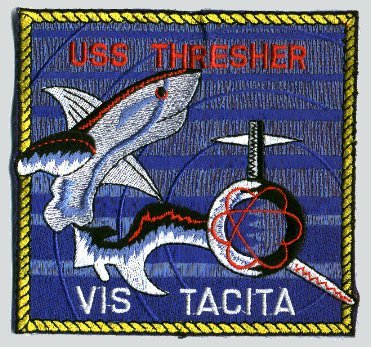
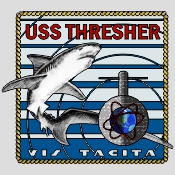
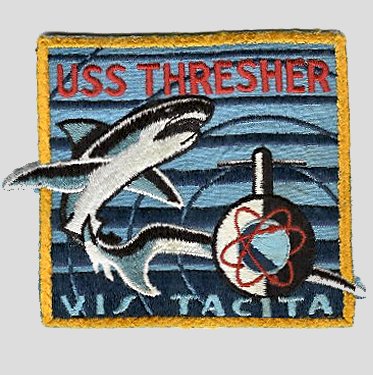
Patch on right contributed by John J. Cook, Decal in middle by unlimiteddetails.com , patch on left contributed by Mike Smolinski
Thresher (SSN-593)

![]()
![]()
![]()
![]()
Awards, Citations and Campaign Ribbons
National Defense Service Medal
Thresher Class Attack Submarine: Laid down, 28 May 1958, at Portsmouth Naval Shipyard, Kettery, ME; Launched, 9 July 1960; Commissioned, USS Thresher (SSN-593), 3 August 1961; Final Disposition, sunk. 10 April 1963, as a result of a casualty during diving tests, in 1,400 fathoms of water, approximately 220 miles east of Boston, MA; Struck from the Naval Register, 10 April 1963.Specifications: Displacement, Surfaced: 3,540 t., Submerged: 4,200 t.; Length 278' 6"; Beam 31' 8"; Speed, Surfaced 15 kts, Submerged 30 kts; Test Depth 1300'; Complement 143; Armament, four 21" torpedo tubes, UUM-44A SUBROC, UGM-84A/C Harpoon, MK57 deep water mines, MK60 CAPTOR mines, Sensors, AN/BQQ-3 & AN/BQS-6 sonar, MK-113 Analog Fire Control System, Propulsion System, one S5W nuclear reactor, two steam turbines, single propeller, 15,000 shp.
These are the things that Thresher itself did not have as it was lost too soon to have it retrofitted onto it:
* 7 bladed propeller (Thresher) only ever had a 5 bladed propeller installed
+ This is a big part of the reason why Thresher itself was nearly as fast as a smaller Skipjack Hull
* The rest of the reason was the number of appendages was reduced significantly over that of the Skipjack/Scamp Class – especially the small sail on all but 613, 614, 615 and 621 on the Thresher/Permit Class)
* The 7 bladed propeller cost any ship it was mounted on, between 2 to 3 knots at the top end vs a 5 bladed propeller
* Retention Tanks in the midship MBT’s (these P&S tanks commenced being put into the hulls in the later in the 1960’s and on into the early 1970’s.
Data above by Steve Walsh & inspired by Ray J. Pryll Jr, STS1(SS) Ret.
| Click On Image For Full Size | Size | Image Description | Contributed By | |
|---|---|---|---|---|
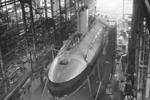 |
369k | Barbel (SS-580) lies stern first towards the camera, 19 July 1958 at the Portsmouth Naval Shipyard. I believe the ways to the left of her was where the Thresher (SSN-593) was being built on 28 May 1958. | USN photo courtesy of Scott Koen & ussnewyork.com | |
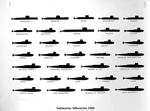 | 179k | Submarine Silhouettes of 1960: Nautilus (SSN-571), Seawolf (SSN-575), Skate (SSN-578), Skipjack (SS-585), Triton (SSRN-586), Halibut (SSGN-587), Thresher (SSN-593), Tullibee (SSN-597), George Washington (SSBN-598), & Ethan Allen (SSBN-608) classes. | USN photo submitted by Ron Titus, courtesy of Ingersoll-Rand. Corp. | |
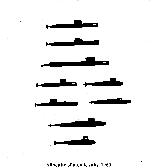 | 187k | Nuclear Submarine Profiles 1960: Nautilus (SSN-571), Seawolf (SSN-575), Triton (SSRN-586), Skate (SSN-578) & Skipjack (SS-585) classes, Halibut (SSGN-587) & Tullibee (SSN-597) classes, George Washington (SSBN-598) & Thresher (SSN-593) classes. | USN photo courtesy of Ron Titus courtesy of Ingersoll-Rand. Corp. Photo i.d. courtesy of David Johnston |
|
 | 50k | Platform plan of Thresher (SSN-593) class submarines. | PDF courtesy of Darryl L. Baker. | |
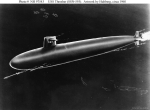 | 59k | Artwork by Hultberg, circa 1960, depicting the submarine's anticipated appearance when completed. It shows two torpedoes being fired from Thresher's (SSN-593) midships torpedo tubes. | Official USN photo # NH 97543, from the collections of the Naval Historical Center. | |
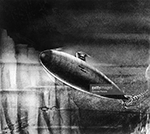 | 1.03k | An artistic rendering shows the hull of the nuclear-powered submarine Thresher (SSN-593) as it speeds through the water, early 1960s. | Photo by Pictorial Parade/Getty Images, courtesy of gettyimages.com. | |
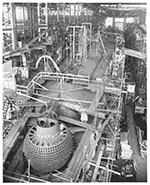 | 253k | Thresher (SSN-593) under construction on the building ways (likely early 1960). | Photo courtesy of Steve Walsh. | |
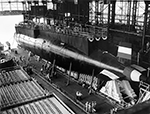 |
566k | Thresher (SSN-593) prior to launching, 9 July 1960. | USN photo courtesy of Dale Hargrave. | |
 0859309 | 657k | Thresher (SSN-593) on the Building Ways prior to launching, 9 July 1960. | USN photo courtesy of Steve Walsh. | |
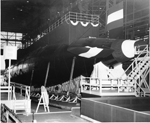 0859309a | 776k | Thresher (SSN-593) on the Building Ways prior to launching, 9 July 1960. | Naval Institute Archives photo courtesy of news.usni.org | |
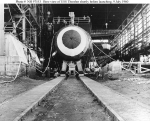 | 143k | Bow view of the Thresher (SSN-593) on the greased building ways, as workmen prepare for her launching at the Portsmouth Naval Shipyard, Kittery, Maine, 9 July 1960. | Official USN photo # NH 97553, from the collections of the Naval Historical Center. | |
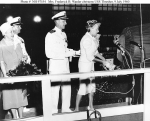 | 92k | Mrs. Frederick B. Warder christens the Thresher (SSN-593), during launching ceremonies at the Portsmouth Naval Shipyard, Kittery, Maine, 9 July 1960. Others present are (from left to right): Mrs. C. Pattisen, Lieutenant Dale E. Deverspicke (Chaplains' Corps), and Captain Henry P. Rumble. Note that the christening took place at Thresher's stern. | Official USN photo # NH 97554, from the collections of the Naval Historical Center. | |
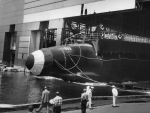 | 438k | Comdr. Dean W. Axene of the Thresher (SSN-593) and her crew salute the colors as she noses into the water for the first time, during launching ceremonies at the Portsmouth Naval Shipyard, Kittery, Maine, 9 July 1960. Her sponsor, Mrs. Frederick B. Warder, is standing by Comdr. Axene's left side. | USN photo courtesy of Ed Martin, LCDR, USN (Retired) | |
 | 434k | Launching of the Thresher (SSN-593) at Portsmouth Naval Shipyard on 9 July 1960. | USN photo courtesy of the Vallejo Naval and Historical Museum via Darryl L. Baker. | |
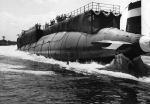 | 380k | Thresher (SSN-593) entering the water for the first time, during launching ceremonies at the Portsmouth Naval Shipyard, Kittery, Maine, 9 July 1960. | USN photo courtesy of Ed Martin, LCDR,USN(Retired) | |
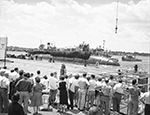 | 257k | View of the Thresher (SSN-593) from the pier from Berth 6, shortly after it was launched. | Photo courtesy of Steve Walsh. | |
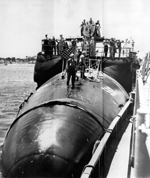 | 315k | Thresher (SSN-593) at her berth at Portsmonth Naval Shipyard after her launching on 9 July 1960. | USN photo courtesy of the Vallejo Naval and Historical Museum via Darryl L. Baker. | |
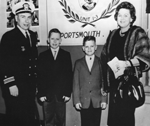 | 212k | Family photo of LCDR John W. Harvey [Last Commanding Officer of Thresher (SSN-593)], sons John and Bruce and Mrs. Irene Harvey at Portsmonth Naval Shipyard after her launching on 9 July 1960. Mrs. Harvey would be the sponsor of the Flying Fish (SSN-673) on 17 May 1969. | USN photo courtesy of the Vallejo Naval and Historical Museum via Darryl L. Baker. | |
 | 69k | Commemorative post mark on the occasion of Thresher's (SSN-593) launch, 9 July 1960. | Courtesy of Jim Richardson. | |
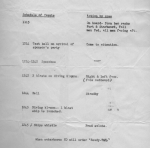 | 61k | Launching script of the Thresher (SSN-593), 9 July 1960, prepared by Bob Rawlins, former XO. | USN photo courtesy of Ed Martin, LCDR, USN (Retired) | |
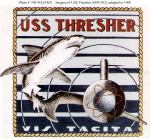 | 131k | Insignia: Thresher (SSN-593). Emblem adopted in 1960 and received in October of that year. It was accompanied with this description: "The fish depicted in the subject insignia is a Thresher shark, which is characterized by a tail that is approximately one-half of its total length. The Thresher shark reportedly attacks its prey by flailing the long tail. The horizontal lines signify the deep diving capability of Thresher. The circles represent her sonar capability. The motto, 'Vis Tacita', describes the overall characteristics of the ship, 'Silent strength'." | Official USN photo # NH 91424-KN, from the collections of the Naval Historical Center. | |
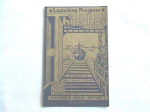 | 40k | Launching pamphlet of the Thresher (SSN-593). | Courtesy of John J. Cook. | |
 | 273k | Thresher (SSN-593) alongside the sound pier at Portsmouth Naval Shipyard, and looks to have been taken when it was doing builders trials, prior to commissioning (it has instrumentation fairings (likely strain gauges) on the hull, just at the aft end of the sail – that was not on the ship after commissioning). | Photo courtesy of Steve Walsh. | |
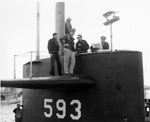 |
136k | Some of Thresher's (SSN-593) officers on her sail. The tall officer standing on the sail plane is LT Ted Hussey. The officer standing in the sail cockpit is the Captain, CDR Dean Axene. | Photograph courtesy of Ron Reeves (of blessed memory) | |
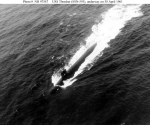 | 99k | Thresher (SSN-593), port bow aerial view, taken while the submarine was underway on 30 April 1961. Photographed by J.L. Snell. | Official USN photo # NH 97547, from the collections of the Naval Historical Center. | |
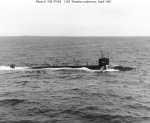 | 92k | Thresher (SSN-593), starboard broadside view, taken while the submarine was underway on 30 April 1961. Photographed by J.L. Snell. | Official USN photo # NH 97548, from the collections of the Naval Historical Center. | |
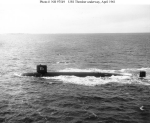 | 101k | Thresher (SSN-593), port broadside view, taken while the submarine was underway on 30 April 1961. Photographed by J.L. Snell. | Official USN photo # NH 97549, from the collections of the Naval Historical Center. | |
 0859306 | 5.37k | High resolution photo of Thresher (SSN-593), starboard quarter view, taken while the submarine was underway on 30 April 1961. Photographed by J.L. Snell. | Official USN photo # NH 97551, from the collections of the Naval Historical Center. | |
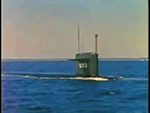 | 29k | PDF of three free photos following Thresher (SSN-593) flowing in color, 1961. | Photos courtesy of Steve Walsh. | |
 | 160k | Thresher (SSN-593) at sea, 1961. | USN photo courtesy of Scott Koen & ussnewyork.com. | |
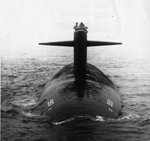 | 3.05k | Thresher (SSN-593), bow-on view, taken at sea on 24 July 1961. | Official USN photo # NH 97545, from the collections of the Naval Historical Center. | |
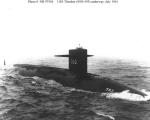 | 100k | Thresher (SSN-593), starboard bow view, taken at sea on 24 July 1961. | Official USN photo # NH 97544, from the collections of the Naval Historical Center. | |
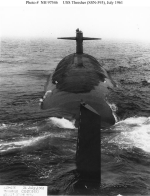 | 97k | Stern-on view of the Thresher (SSN-593), taken at sea on 24 July 1961. Note upper rudder in the foreground, with draft markings painted on its side and navigation light at its top. | Official USN photo # NH 97546, from the collections of the Naval Historical Center. | |
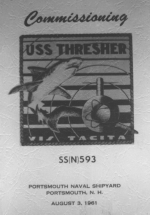 | 953k | Eight page PDF Commissioning pamphlet of the Thresher (SSN-593). | USN photo courtesy of Scott Koen & ussnewyork.com. | |
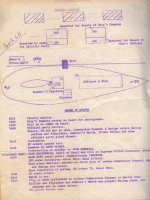 | 121k | Order of events for the commissioning for the Thresher (SSN-593), 3 August 1961, prepared by Bob Rawlins, former XO. | USN photo courtesy of Ed Martin, LCDR, USN (Retired) | |
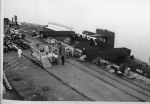 | 410k | Dock yard workers and other officials setting up the commissioning platform for the Thresher (SSN-593), shortly before she was officially entered into the USN on 3 August 1961. | USN photo courtesy of Ed Martin, LCDR, USN (Retired) | |
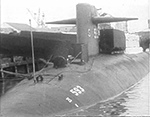 | 137k | Thresher (SSN-593) during its commissioning on 3 August 1961 at near waterline level. The commissioning picture is not a very sharp picture, but it is still a good shot of the ship, especially as it shows its smooth lines and offsets, which was the design intent as they wanted the larger ship to go as nearly as fast as the class before it, the Skipjack Class, using the same drive train. | Photo & text courtesy of Steve Walsh. | |
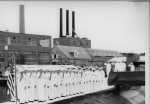 | 293k | Officers & crew salute the colors onboard the Thresher (SSN-593), 3 August 1961, outside building # 5 at Portsmouth Naval Shipyard, Kettery, ME. | USN photo courtesy of Ed Martin, LCDR,USN(Retired) | |
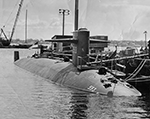 | 371k | View of the Thresher (SSN-593) at Sound Pier Dock. | Photo courtesy of Bruce Harvey via Steve Walsh. | |
 | 121k | Cut out of the Thresher (SSN-593) class, showing the offending periscope in the after part of the sail. Masts, fore to aft, are: snorkel/air induction; SS-2A radar; VLF loop; UHF/IFF & MHF antenna; ECM; and periscope. The emergency diesel generator was in the lowest level compartment of the bottle-nose, directly under the snorkel, with a sonar equipment room forward of it. Crew's quarters were above it. The sonar room was on the upper level near the ship's control center and attack center. | Photo & text courtesy of U.S. Submarines Since 1945, An Illustrated Design History by Norman Friedman & James L. Christley.Naval Institute Press. | |
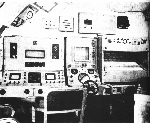 | 157k | Thresher (SSN-593) was designed around her sonar. This is the passive side of the sonar control room, with consoles for (left to right) BQG-1 (PUFFS), BQR-7, & BQQ-3. BQG-1 correlated the outputs of a pair of sub-arrays, hence the two small displays and the big screen to match them. BQR-7 had two beams, one steered manually (using the hand wheel, with a bearing indicator above it) and one continuously scanned (feeding a bearing-time recorder, whose paper output showed in the rectangle above). BQQ-3 was a Lofargram recorder; the pen moved across the paper along the bar visible in the middle of the paper. | Photo courtesy of Raytheon Corp & text courtesy of U.S. Submarines Since 1945, An Illustrated Design History by Norman Friedman & James L. Christley. Naval Institute Press. | |
 | 62k | Thresher (SSN-593) sonar arrangement, showing the bow sphere, the staves of BQR-7, and the equipment space control room (which was not in the control or attack center). | Photo & text courtesy of U.S. Submarines Since 1945, An Illustrated Design History by Norman Friedman & James L. Christley.Naval Institute Press. | |
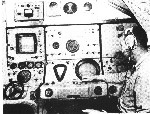 | 161k | Thresher's (SSN-593) BQS-6/BQA-3 sonar room: passive BQS-6 console, active BQS-6 active console, and a BQA-3 graphic indicator, which measured target Doppler. As in BQR-7, there were two passive beams, one steered for tracking (using the hand wheel, with bearing indicated on the dial above) and one continuously scanning (feeding the bearing-time paper recorder above the hand wheel). Raw video, its beams formed by an amplifier-scanner, went to the passive console. A sonar receiver processed video to extract echoes for the active console and for BQA-3. The active console could also receive pings extracted by a separate receiver-scanner. The triangular indicator (SSI, sector-scan indicator) alongside the PPI allowed comparison of right and left hand beams for finer measurement; it also could be used to measure depression/elevation angle. Above the main PPI of the active console are direction and depression/elevation indicators for the single-ping pencil-beam active mode. Retrofit III sonars (BQS-11 -13) had a new active sonar receiver in place of the earlier receiver-scanner. Signals passed via the active console to the BQA-3 (BQS-11-12) or via a new data computer and processor to an auxiliary active console. In Retrofit III sonars (BQS-11-13), the up/down & left/right indicators were moved to the lower panel; their place was taken by a small diameter CRT for active operation and the lower displays were replaced by a larger diameter CRT for an A-scan. These sonars also lack the SSI, because they auto-track. Only in BQS-13, the BQA-3 electronic cabinet and display were replaced by a data computer and processor (fed by the active receiver) feeding an auxiliary active console with a single rectangular window. BQS-12 (but not BQS-13) had a modified passive console without a hand wheel. Shown here is First Class Sonarman Robert Edwin Steinel, who was on board Thresher on her final dive. | Photo courtesy of Raytheon Corp & text courtesy of U.S. Submarines Since 1945, An Illustrated Design History by Norman Friedman & James L. Christley.Naval Institute Press. | |
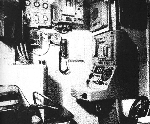 | 158k | The BQQ-2 operating concept included a secure underwater communications system (SESCO, BQA-2). Its console is shown on board Thresher (SSN-593) across a passageway from the BQS-6 passive console). SESCO died, mainly of multipath. That turned out to be fortunate because space for additional sonar equipment was soon needed. | Photo courtesy of Raytheon Corp & text courtesy of U.S. Submarines Since 1945, An Illustrated Design History by Norman Friedman & James L. Christley. Naval Institute Press. | |
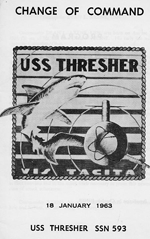 | 271k | Four page PDF COC pamphlet of the Thresher (SSN-593), 18 January 1963. | USN photo courtesy of Scott Koen & ussnewyork.com. | |
 | 1.43k | Welcome Aboard Pamphlet Thresher (SSN-593). | Photo courtesy of Steve Walsh. | |
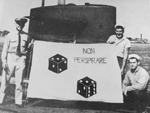 0859374 | 417k | The dice number spell out Thresher (SSN-593): Crew Members Standing Walter J. Noonis RMC(SS) and Norman G. Lanouette, QM1(SS) kneeling Thomas E. Clements ETR3(SS). All three men would be lost with the boat on her last voyage. |
Photo courtesy of Steve Walsh. | |
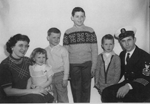 0859390 | 443k | EMCM (SS) Benjamin Shafer and his family. From left to right: Connie, Penny, Pete, Steve, Mike and Ben. This family picture is courtesy of Mike. Mike lost both his dad (Ben) and his Uncle ENCS (SS) John Shafer (Ben’s brother) on Thresher (SSN-593) on 10 April 1963. | USN photo courtesy of Steve Walsh. | |
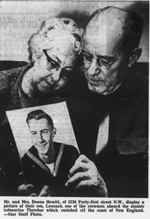 0859340 | NR | Mr. and Mrs. Downs Hewitt, of 5330 Forty-first street N.W., display a picture of their son, Leonard, one of the crewmen aboard the atomic submarine Thresher (SSN-593) which vanished off the coast of New England. | Star Staff Photo. Image and text provided by Library of Congress, Washington, DC. Photo from Evening Star. [volume] (Washington, D.C.) 1854-1972, 11 April 1963, Image 4, via chroniclingamerica.loc.gov. |
|
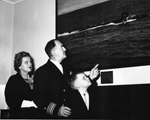 0859376 | 517k | Mrs John W. Harvey, widow of Lt. Cmdr. John W. Harvey, skipper Thresher (SSN-593), Rear Adm. Robert W. Cavenagh, Commandant 4th Naval Dist., Son, Bruce Harvey, 9 yrs. | Naval Institute Archives photo courtesy of news.usni.org | |
 | 122k | John Wesley Harvey, Lieutenant Commander (Commanding Officer) of the Thresher (SSN-593) at the time of her loss is shown here (3rd from the left, near the door) in a photo aboard the Nautilus (SSN-571) as she was heading for the surface at a sharp angle, her crew is thrown off balance in their mess like men in an amusement park crazy house, May 1956. When the Thresher was flooding from her stern, the scene aboard her was undoubtedly worse as the boats' angle probably rose until the implosion. Imagine trying to work in an environment uphill, probably without power and in the realization that everyone's life is in the balance with time running out. Undoubtedly their training kept the men busy trying to save the boat and they were at their posts doing what they had been taught to do until the last moment. The acoustic bubble-pulse data indicate the Thresher pressure hull and all internal compartments were completely destroyed in less than one-tenth of a second (100 milliseconds), significantly less than the minimum time required for human perception of any event: 50 milliseconds for retina integration plus 100 milliseconds for cognitive integration. Lieutenant Commander Harvey appears here in an official navy photo. |
Partial text courtesy of Bruce Rule as quoted in Subject: Why the Thresher (SSN-593) Was Lost? which appears near the bottom of this page. Photographer: Hank Walker, courtesy of Life. USN photo courtesy of oneternalpatrol.com. |
|
 | 114k | Parents of US nuclear submarine Thresher (SSN-593) skipper John Harvey, on telephone after hearing his sub was reported missing at sea with 129 men aboard. | Photo by James Drake/The LIFE Images Collection/Getty Images, courtesy of gettyimages.com. | |
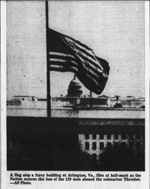 0859363a |
NR | A flag atop a Navy building at Arlington, Va., flies at half-mast as the Nation mourns the loss of the 129 men aboard the submarine Thresher (SSN-593). | General Dynamics Corp. Photo Image and text provided by Library of Congress, Washington, DC. Photo & text by Evening Star. [volume] (Washington, D.C.) 1854-1972, 12 April 1963, Image 1, via chroniclingamerica.loc.gov. | |
| Memorial Service | ||||
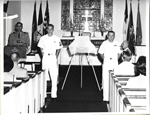 0859310 |
595k | Thresher (SSN-593) Memorial Service 3 August 1963: Standing (Left to Right) CDR Dean Axene 1st CO of Thresher, & two former Thresher crewmen who transferred to the John Adams (SSBN-620) then under construction at Portsmouth Naval Shipyard, Ronald L Estes IC-2 and Paul D. La Riviera HM-1 (2). | Photo courtesy of Ron Estes & Steve Walsh. | |
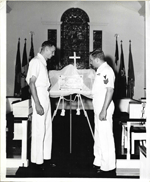 0859310a |
485k | Thresher (SSN-593) Memorial Service 3 August 1963. Two former Thresher crewmen who transferred to the John Adams (SSBN-620), then under construction at Portsmouth Naval Shipyard, Ronald L Estes IC-2 and Paul D. La Riviera HM-1 (2). | Photo courtesy Ron Estes & Steve Walsh. | |
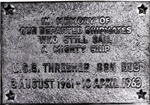 0859310p |
967k | Thresher (SSN-593) Memorial Plaque, 3 August 1963. | Photo courtesy of Ron Estes & Steve Walsh. | |
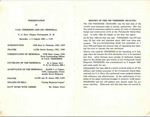 08593s |
413k | Thresher (SSN-593) Memorial Service, 3 August 1963. | PDF courtesy of Ron Estes & Steve Walsh. | |
| Loss & Inquiry | ||||
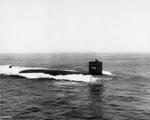 | 411k | Thresher's (SSN-593) Remains Located The Navy announced that it has obtained photos of the hull of the nuclear submarine Thresher, shown here in a 1961 file photo, which went down in 8,500 feet of water with her 129-man crew on 10 April 1963. Photos were taken by a task group headed by the deep-diving bathyscaph Trieste II, about 200 miles east of Cape Cod. | Photo by Bettmann via Getty Images courtesy of gettyimages.com. | |
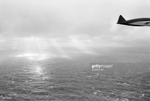 | 316k | Search mission on the scene of the tragedy by a US Army aircraft. | Photo by Paul Slade / Paris Match via Getty Images courtesy of gettyimages.com. | |
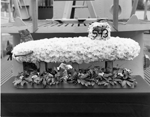 0859375 | 689k | Floral replica of Thresher (SSN-593). | Naval Institute Archives photo courtesy of news.usni.org | |
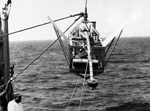 |
1.05k | "The Fish", an underwater camera magnetometer device, being lowered from Mizar (T-AGOR-11). Despite the tragic loss, Thresher (SSN-593) afforded the Navy an opportunity to evaluate advanced equipment and improve techniques of deep water search and inspection. Photographs were taken at a depth of more than 8,000 feet with an improved underwater camera-magnetometer device towed by Mizar and operated from the surface by personnel of the U.S. Naval Research Laboratory. Visual inspections were conducted and photographs were taken by men aboard the Navy's remodeled bathyscaph Trieste II. |
USN photo # USN 1104636-D, Photographed by PHC C.L. Wright, courtesy of the National Museum of the U.S. Navy, via flickr.com. | |
 0859372 | 2.85k | Diagram of depth at Thresher (SSN-593) sinking. | Photo courtesy of Steve Walsh. | |
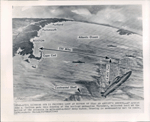 | 610k | Thresher (SSN-593) Wreck Site Sketch drawn by the AP artist John A. Carlton on 11 April 1963. | USN photo courtesy of Ron Reeves (of blessed memory) | |
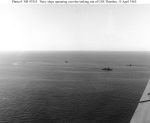 | 57k | Navy ships circle in the vicinity of the site of Thresher's (SSN-593) sinking, 15 April 1963, five days after her loss. Ships are (left to right): Thomas Jefferson (SSBN-618); Sunbird (ASR-15); Warrington (DD-843), group flagship; and Redfin (SS-272). Photographed by PHCS Parker. | Official USN photo # NH 97555, from the collections of the Naval Historical Center. | |
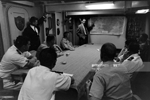 0859373 | 867k | Group of men listening to a plan to search for the nuclear-powered attack submarine Thresher (SSN-593), May 1963 | Photo by Fritz Goro/The LIFE Picture Collection via Getty Images courtesy of gettyimages.com. | |
 |
18.1k | 41 photo PDF Thresher's (SSN-593) sinking. These photos of Thresher are the results of a Freedom of Information Act (FOIA) by James B. Bryant submitted by Robert Eatinger of Dunlap Bennett & Ludwig for the Thresher's 1963 Naval Court of Inquiry and related records. We hope readers and Congress will support efforts to release these records in time for us to get some answers before the dedication of the Thresher Memorial in Arlington National Cemetery in September 2019. The final ten minutes of the Thresher are detailed in the March 2018 Proceedings (p. 87). |
Photographs courtesy of Jim Bryant & Steve Walsh. | |
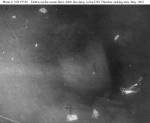 | 68k | "Debris on the ocean floor 8,400 feet below the surface may be a clue to the final resting place of the nuclear submarine Thresher (SSN-593). Taken last week by an underwater camera system operated by the oceanographic research vessel Atlantis II, these photographs show scattered bits of unidentified debris. The round objects are sea urchins which may range in size from four to twelve inches in diameter. The Navy states that the photographs in themselves are not conclusive evidence of the location of the missing submarine which sank on 10 April 1963, 220 miles east of Cape Cod. Ships of the searching force are continuing a minute search of the area with underwater cameras, sonar and other detection devices." Quoted from the original caption released with this photograph on 22 May 1963. | Official USN photo # NH 97556, from the collections of the Naval Historical Center. | |
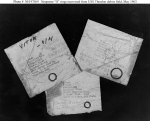 | 99k | "Three of fifteen packages of neoprene 'O' rings recovered by drag lines from the Lamont Laboratories oceanographic research ship Conrad in the area of prime interest in the search for the nuclear submarine Thresher (SSN-593). The recovery was made on the 28th of May, and the package was forwarded to the Court of Inquiry, Portsmouth, N.H., for examination. After examination and tracing of stock numbers it was definitely determined that one of the fifteen packages could have come only from the Thresher. The 'O' rings are shown on the packaging material after opening." The original view, from whose caption the quoted text is taken, was released on 1 June 1963. | Official USN photo # NH 97569, from the collections of the Naval Historical Center. | |
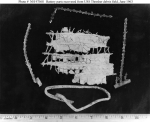 | 75k | "Parts of a battery recovered by the Navy's bathyscaph Trieste during the first series of dives June 24th through 30th, 220 miles east of Cape Cod where the nuclear powered submarine Thresher (SSN-593) sank April 10. The centered object is an internal battery grid, encircled by re-enforcing members." The original view, from whose caption the quoted text is taken, was released on 5 September 1963. | Official USN photo # NH 97568, from the collections of the Naval Historical Center. | |
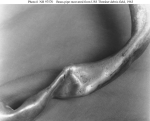 | 58k | "This brass pipe, with the inscription: 'JO 10 ... 3-O-5091-05; DM 263-109-61; PL-1862791 PC.75; 1.050 Brass Pipe; 593 Boat', was recovered by the bathyscaph Trieste during the second series of dives in the search for Thresher (SSN-593). The nuclear powered submarine which sank April 10 some 220 miles east of Cape Cod had the hull number '593'." The original view, from whose caption the quoted text is taken, was released on 13 September 1963. | Official USN photo # NH 97570, from the collections of the Naval Historical Center. | |
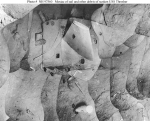 | 121k | "Mosaic of the sail. The conning station is at Arrow (1), upside down with the leading edge to the left in this photograph. The sail planes (2) are completely reversed. Below the sail is a torpedo shutter door (3). An air bottle is at (4) ... . Actuating gear for torpedo shutter door (5)." Quoted text is from the caption released with the original image, which was received by the Naval Photographic Center in December 1966. View shows the starboard side of the sail. | Official USN photo # NH 97560, from the collections of the Naval Historical Center. | |
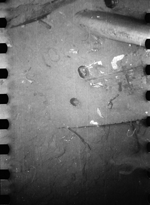 | 703k | "Starboard side of the Thresher (SSN-593) sail with portions of the hull number '593' visible." Photographed from a deep-sea vehicle deployed from Mizar (T-AGOR-11). The original photograph bears the date October 1964. Quoted text is from the caption released with that print. | Official USN photo # NH 97559, courtesy of the National Museum of the U.S. Navy, via flickr.com. | |
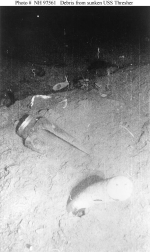 | 68k | High pressure air flask and other debris on the ocean floor in the vicinity of the Thresher (SSN-593)." The original view, from whose caption the quoted text is taken, is undated. It shows an area of wreckage next to the top of the submarine's sail. | Official USN photo # NH 97561, from the collections of the Naval Historical Center. | |
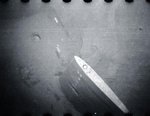 | 500k | Overhead view of Thresher's (SSN-593) upper rudder, photographed from a deep-sea vehicle deployed from Mizar (T-AGOR-11). The view shows draft markings on the rudder side and a navigation light at its top. The original photograph bears the date October 1964. Thresher was lost on 10 April 1963. | Official USN photo # NH 97557, courtesy of the National Museum of the U.S. Navy, via flickr.com. | |
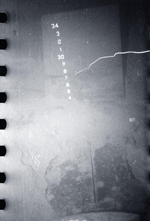 | 824k | "Draft markings on the topside rudder of Thresher (SSN-593). Part of the port stern plane of the sunken sub can be seen in the foreground. The bit of line on the right is connected to the underwater camera-magnetometer sled towed by Mizar (T-AGOR-11)." The original photograph bears the date October 1964. Quoted text is from the caption released with that print. | Official USN photo # NH 97558, courtesy of the National Museum of the U.S. Navy, via flickr.com. | |
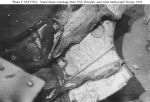 | 78k | "Sonar Dome -- A section of a sonar dome from the bow of a Thresher class submarine photographed August 24 during the second series of dives by the bathyscaph Trieste. The bathyscaph has completed 10 dives some 220 miles east of Cape Cod where the nuclear powered submarine Thresher (SSN-593) sank April 10." The original view, from whose caption the quoted text is taken, was released on 5 September 1963. | Official USN photo # NH 97562, from the collections of the Naval Historical Center. | |
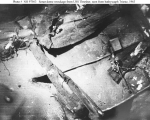 | 106k | "Sonar Dome -- An external portion of a sonar dome used exclusively in Thresher class submarines was photographed by the bathyscaph Trieste. August 24 during the second series of dives in the area where the nuclear powered submarine Thresher (SSN-593) sank April 10." The original view, from whose caption the quoted text is taken, was released on 5 September 1963. | Official USN photo # NH 97563, from the collections of the Naval Historical Center. | |
 | 66k | "A fragment of the anchor from the Thresher (SSN-593) located near the wreckage." The original view, from whose caption the quoted text is taken, is undated. | Official USN photo # NH 97564, from the collections of the Naval Historical Center. | |
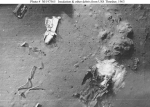 | 82k | "Insulation -- Rockwool thermal insulation photographed August 24 during the bathyscaph Trieste's second series of dives some 220 miles east of Cape Cod where Thresher (SSN-593) sank April 10. This type of insulation is used in all U.S. submarines." The original view, from whose caption the quoted text is taken, was released on 5 September 1963. | Official USN photo # NH 97565, from the collections of the Naval Historical Center. | |
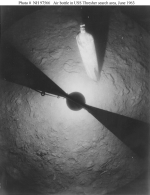 | 57k | "Photographs taken by Conrad, Lamont Laboratory's research ship, on 14 June 1963 in the Thresher (SSN-593) search area. An air bottle similar to that carried aboard Navy ships. The diagonal lines and the ball in the center of the picture is part of the lighting system for the underwater camera." The original view, from whose caption the quoted text is taken, was released on 19 June 1963. | Official USN photo # NH 97566, from the collections of the Naval Historical Center. | |
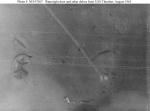 | 64k | A picture of one of the many Boiler Type Manhole Covers used on Thresher (SSN-593) and its sister ships. It closes off the manhole access to tanks such as the Normal Fuel Oil (NFO) Tank separating the Op’s from the Reactor Compartment; the After Trim (Aft Trim) Tank, Auxiliaries (Aux) 1 & 2 Tanks; Sanitary (San) Tanks; external to the pressure hull hard tanks such as the Forward Trim (Fwd Trim) Tank and Negative (Neg) Tank; etc. Photo taken 24 August during the bathyscaph Trieste's second series of dives some 220 miles east of Cape Cod where the nuclear powered submarine Thresher (SSN-593) sank 10 April 1963." The original view, from whose caption the quoted text is taken, was released on 5 September 1963. | Text courtesy of Steve Walsh. Official USN photo # NH 97567, from the collections of the Naval Historical Center. |
|
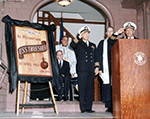 | 1.30k | Dedication of the Thresher (SSN-593) plaque at St. Peters Chapel at Mare Island on 10 April 1964. The chapel was built in 1901 and still stand at the former shipyard. The plaque is still in place as well. Left to right: Capt. F. M. Smith (Production Officer), CDR C. H. Swift, Jr. (CHC) and RADM E. J. Fahy (Shipyard Commander). | USN photo # 62890-4-64, courtesy of Darryl L. Baker. | |
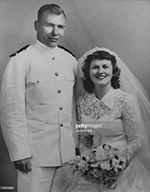 | 575k | John W. Harvey with his wife Irene Nagorski after their wedding ceremony; ten years later he would die as the skipper on the nuclear submarine Thresher (SSN-593). | Photo by James Drake/The LIFE Images Collection/Getty Images, courtesy of gettyimages.com. | |
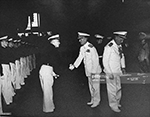 | 351k | The only reason that there is a 4 photo PDF of Thresher's (SSN-593) CO John W. Harvey is due to the coverage that he received in the photos that I have found of his life. The 1st photo shows him receiving his diploma from Naval Academy where he graduated 8th in his class. The 2nd while he was a guard on the Navy football team; the last two are of his sons. | Photo by James Drake/The LIFE Images Collection/Getty Images, courtesy of gettyimages.com. | |
| 1998 views | ||||
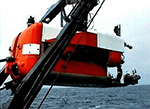 | 273k | Here are some pictures of Thresher (SSN-593) on the bottom, taken by the unmanned vehicle (UMV) Advanced Tethered Vehicle (ATV) back in the middle of 1998.
- This photo is a portside picture of the upper rudder and the newly installed PUFFS Fairing, installed during the Post Shakedown Availability (PSA) that the ship was performing its first deep dive on as part of its post-PSA sea trials. - The two air bottles are pictures of the ships HPAir Flasks that were ejected out of one or more Main Ballast Tanks (MBTs) when the ship's hull imploded. These curved flasks are known as ‘banana bottles' as they follow the shape of the inboard face off the MBT shell plating. - The sail (also known as the fairwater) is seen laying on its portside with the leading edge of the stbd sail (fairwater) plane rotated nearly 180 degrees aft. o The attached B&W picture of the same side of the sail with the ship pierside on 28 May 1962, is shown for reference. You can seen the leading edge of that sail plane in its proper orientation and not spun nearly 180 degrees aft. - The dome was the outer shell protecting the sonar sphere and providing the bow fairing to the ship. When the sphere itself imploded, it blew apart this freeflooding fairing o It is readily identified by the truss work, vice "T" type of framing, holding the shell plating to its correct lines and offsets § The truss type of framing was used to minimize ‘masking' of the signals received by the passive and sent by the active sonar in that freeflood. These are undoctored ATV pictures and their original labels, thus the blue tint in them. | ATV photo via fas.org. Photos & text courtesy of Steve Walsh. |
|
| Memorial | ||||
 | 42k | Thresher (SSN-593) Marker Buoy Label. | USN photo courtesy of ussthresher.com. | |
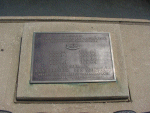 | 91k | Memorial plaque at Independence Seaport Museum, Philadelphia PA, July 2006 for the crews of United States submarines lost during peace time accidents: F-1 (SS-20), F-4 (SS-23), G-2 (SS-27), H-1 (SS-28), O-5 (SS-66), O-9 (SS-70), S-4 (SS-109), S-51 (SS-162), Squalus (SS-192), Scorpion (SSN-589) & Thresher (SSN-593). | Photo courtesy of Wendell Royce McLaughlin Jr. | |
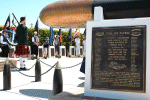 |
669k | Active duty and veteran submariners stand together at the 29th annual "Tolling The Boats" Memorial Service held at the World War II National Submarine Memorial-West, Naval Weapons Station Seal Beach, Calif. May 29, 2006. The ceremony honored members of the Silent Service who gave their lives during World War II and the Cold War for their country and the cause of freedom. | USN photo # N-1159B-052 by Journalist 1st Class Brian Brannon, courtesy of navy.news.mil. | |
 |
92k | Thresher (SSN-593) was honored with a special postmark. | Photograph courtesy of seacoastonline.com via Ron Reeves (of blessed memory) | |
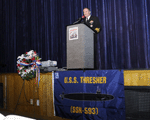 |
542k | Vice Adm. Michael Connor, commander of Submarine Forces, delivers remarks during a memorial service for the 50th anniversary of the loss of the U.S. Navy submarine Thresher (SSN-593). The ceremony honored the 129 men lost on Thresher, which sank off the cost of Cape Cod on 10 April 1963 during sea trials. More than 700 Thresher family members and former crew members attended the service. | USN photo # 130406-N-TT535-002 by Jim Cleveland, courtesy of navy.news.mil. | |
 |
207k | Nearly 1,000 relatives, former shipmates and coworkers of the 129 brave pioneers came together to commemorate the 50th anniversary of the loss of Thresher (SSN-593) at a ceremony held at Portsmouth High School 6 April 2013. | USN photo # 130406-N-TN558-014 by Mass Communication Specialist 1st Class (SW/EXW) Jason J. Perry, courtesy of navy.news.mil. | |
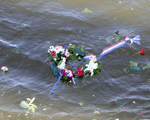 |
517k | A wreath floats 6 April 2013 in the Piscataqua River off the Memorial Bridge to honor the 129 men lost on aboard the U.S. Navy submarine Thresher (SSN-593), which sank off the cost of Cape Cod on 10 April 1963 during sea trials. | USN photo # 130406-N-TT535-008 by Jim Cleveland, courtesy of navy.news.mil. | |
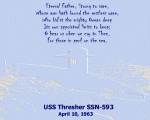 | 38k | The Thresher sank during the deep dive portion of Phase C Sea Trials in April 1963. Quite a bit was known (and later discovered) about the Thresher disaster. Sadly, the same cannot be said of the sinking of the Scorpion (SSN-589). The Scorpion was lost during a mission in 1968 and while the U.S. Government convened inquiries, it has never issued any official explanation or cause of the loss, and instead has left the door open to several theories. This lack of closure is a void that has over the years been filled by poorly researched cloak-and-dagger accounts of the loss of the Scorpion. The following is a copy of a letter written by Neal Collier to the Scorpion Families on the Scorpion-99 Yahoo Group. It was written in response to the most recent of these ‘un-official' accounts. It is reprinted here because it contains some Thresher-related information, but more importantly to show that these two ships, the men that were lost, and the families and loved-ones left behind are inexorably linked in history – past, present, and future. For the Scorpion 99, John Howland I was 4 when my father was lost on the Thresher. He had transferred on as the Engineer's relief just prior to Sea Trials. I don't think he was even part of the crew for more than a few weeks. I went in to the Navy myself – many different reasons – and ended up on the Archerfish (SSN-678), meeting the boat in the Med. After about a year we went to the Portsmouth Naval Shipyard (PNS) for an overhaul. The PNS was where the Thresher had undergone her last overhaul, and from which she went on her last dive. While there I took the opportunity to speak to a LOT of SY Workers and Navy types. I discovered that the PNS took the Thresher sinking very seriously and take the hard-earned lessons to heart in everything they do. The Shipyard lost officer observers and civilian Shipyard workers when the Thresher sank. Many people forget that. Each and every person that I spoke to who worked on her or remembered her was reduced to tears when we discussed the tragedy. So what happened? Why did the Thresher sink? The sad fact is that usually the reason bad things happen is that humans are involved and humans, well, they make a lot of mistakes. For the Thresher, there were so many mistakes made it is difficult to name them all. One that comes to mind is the depth of water in which she sank. Test Depth is a certain depth. It's classified, but for argument's sake let's say Test Depth is 400 feet. (It is deeper than that, but we'll use that in this example.) If you were conducting deep depth test and the boat could only go safely to 400 feet, you probably would want to be in water that was just a bit deeper than that. You would also want to have the ability to provide support if trouble occurred. The Thresher was on the way to Test Depth in water that was about 8400 feet deep and no rescue vessels were in the vicinity. Think about the monumental arrogance and stupidity that resulted in that location being chosen. There were others, but the gist here is that many, many mistakes were made. From that tragedy, though, came many positive changes. SUBSAFE was the big one. Design and operational changes occurred, too. - SUBASFE - A complex and comprehensive submarine overhaul maintenance and repair management system with checks and double-checks to ensure any / all critical operational and safety components are thoroughly tracked, tested, and checked after maintenance, repair, or modification prior to allowing them to be released for use. - Moisture separators on the High Pressure Air Compressors (HIPACS) to remove moisture known to cause the 'Venturi Effect' which freezes the Tank Emergency Main Ballast Tank Blow Valves when they are needed the most. - Prior to the Thresher disaster, submarines were routinely put through a gauntlet of depth charges causing structural damage that was then measured and evaluated. This is no longer done to operational vessels. - Fast SCRAM recovery. The ability to rapidly and safely bring the reactor (the steam source for the engines to turn the propeller) back from a shutdown state. - Equipment Cooling. Prior to the Thresher, equipment was cooled mainly from pipes that carried seawater through tubes that cooled the equipment. This meant that there were many feet of pipe throughout the sub carrying water at extreme pressures. Design changes were made to install large heat exchangers that transferred cold from the seawater to fresh water at much lower pressures. The fresh water was then pumped to the equipment to cool it. - Silver brazing and radiography. When pipe was cut and welded, a special silver braze was used to seal the weld and make it water tight. Silver welding was hard to get right and many welds were not able to withstand the pressures to which they were subjected. This practice was ultimately stopped. In addition, very few welds were looked at using radiography (think of the dentist looking at your teeth). Taking radio-graphic pictures of critical welds is now done (and in some cases re-done) for all piping and hull welds. The above are a few major examples. I hasten to add that the Thresher did not 'create' these changes; they (and many more) were already being studied, debated, and discussed at the time. The Thresher was only the catalyst to make them happen; to push it through Congress. I do not know a lot about the Scorpion but have read a few books and accounts. From a Scorpion perspective, I think the article from Proceedings (July 1998) summed it up as the Navy just did not learn the lessons from the Thresher. A stuck Trash Disposal Unit (TDU) valve was postulated as the most probable reason the Scorpion was lost. A guy I knew on the Shark (SSN-591) (sister ship to the Scorpion) said that TDU valve got stuck on a mission and the Captain would not let anyone touch it until they got into port. They must have been teaching that as a potential problem at Prospective Commanding Officer's (PCO) School. People just like the sexy conspiracy stuff, I guess. Revenge for the sinking of the .... Wait a minute. What, now? Our culture loves a good story and we want so desperately to believe the unbelievable. When in Orlando at a Navy service school I heard of the "Thresher Tape" where supposedly members of the crew left messages to loved ones that the Skylark (a recording and communications ship) picked up before she sank. I heard this from many different people at different commands. I searched at several different commands in a vain attempt to find that recording. It took me until years after I got out of the Navy to come to the realization that it was baloney. A family friend (USNA '56) explained it to me this way "OK, the ship is sinking. Are you going to work like heck to fix it, or are you going to line up outside the Radio Room to record a message?". I was at a Naval awards ceremony a few years back and a female officer (LtCDR) informed me at the reception that her husband told her of a top secret mission where the Thresher actually had SEALS on board during Phase C Sea Trials. I have to tell you, had I said to her what I was actually thinking at the time, I probably would have been thrown off that base. There are other examples (too many, unfortunately). People who you would think know better don't. There are all these crazy theories and stories. Thankfully, there are no books written about the Thresher (except maybe the Polmar book), so I don't have to go through that. I was recently lent a book about the 'secret' submarine war by a co-worker who is also ex-Navy. After a quick scan I was not happy with what I read and did a web search on the book. The results (poorly researched, mostly fiction, etc.) confirmed my suspicions. I spoke to the guy who lent it to me, explaining how I would feel if idiots who actually believe the tripe sent out via emails wrote a book about some plot against the Soviets involving the Thresher; involving these noble men who gave their lives for their country; cheapening their memory and honor for a few bucks, for some fame, for --- what exactly? When I told my co-worker this he leaned back in his chair and said very humbly, "I hadn't thought of that."The crazy theories and stories make me sick and angry, to be honest. They create a false and phantom history and – in my view – move the discussion farther away from where it needs to be: how can we create a stronger and safer submarine force and never NEVER let this kind of tragedy happen again? OK. I have said enough. As a closer I would say that we need to be vigilant, to keep the memories alive, and to stay true to our loved ones and their memory through memorial services and discussions. We need to keep the memory of those lost – and how they were lost – alive for this and future generations. 1 - "Those who don't know history are destined to repeat it." Edmund Burke (1729-1797) 2 - We honor those who we love and respect. When we stop doing that we lose our humanity. 3 - Memorial services give those who have not grieved the opportunity to do so when they are ready. Sincerely, Neal Collier In Memorium: In the Second Book of Shmuel (Samuel), 22nd chapter, 5th through the 20th verses, translated from the original in Hebrew and published by the Koren Publishers of Jerusalem, Israel, 1982, can perhaps aptly describe the fate of the crew and all other U.S. submariners who died defending their county: "When the waves of death compassed me / the floods of ungodly men made me afraid; / the bonds of She'ol encircled me; / the snares of death took me by surprise; / in my distress I called upon the Lord, / and cried to my G-D: / and he heard my voice out of his temple, / and my cry entered into his ears. / Then the earth shook and trembled; /the foundations of heaven moved / and shook because of his anger /...the heavy mass of waters, and thick clouds of the skies /... And the channels of the sea appeared, / the foundations of the world were laid bare, / at the rebuking of the Lord, at the blast at the breath of his nostrils. / He sent from above, he took me; / he drew me out of many waters; / he delivered me from my strong enemy, and from those who hated me; for they were too strong for me. / They surprised me in the day of my calamity: / but the Lord was my stay / He brought me forth also into a large place: / he delivered me because he delighted in me./" | Photo courtesy of Tom Kermen. Dante's Prayer courtesy of Loreena McKennitt via loreenamckennitt.com | |
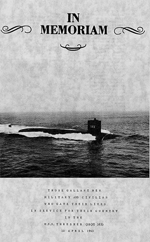 | 306k | Four page Memorial PDF pamphlet of the Thresher (SSN-593).
I WAS THE ONLY ENLISTED (YN1) ASSIGNED TO THE SUBMARINE OFFICER PLACEMENT DESK IN BUPERS WHEN THIS TRAGIC EVENT OCCURED. WE HAD BEEN INFORMED BY SUBLANT OF THE INCIDENT MID- AFTERNOON BUT COULD NOT TAKE ANY ACTION UNTIL IT WAS OFFICIALLY ANNOUNCED SHORTLY AFTER THE CIVILIAN WORKFORCE HAD DEPARTED. MY BOSS, LT ELMER COOK, AND I WERE TASKED TO PULL THE RECORDS OF THE THRESHER CREW SO THAT CASUALTY INFORMATION COULD BE PREPARED FOR NEXT OF KIN NOTIFICATION. **************************************************************************************** Thresher (SSN-593) Loss: 50 Year Anniversary On 10 April 2013 it will be the 50th Anniversary of the loss of the Thresher. This posting is being made at the request of Bruce Rule, the author of this analysis. It is now possible with recently declassified documentation and other supporting data, all in the public domain, to provide this scientific analysis. A version of this posting has been sent in letter form to ADM K. H. Donald, Director Naval Nuclear Propulsion and Captain L. Bryant Fuller III, Shipyard Commander Portsmouth Naval Shipyard. Subject: Why the Thresher (SSN-593) Was Lost? In April 1963, the author, then the Analysis Officer at the Sound Surveillance System (SOSUS) Evaluation Center in Norfolk, VA, had just completed the U.S. Nuclear Submarine Acoustic Data Handbook, a comprehensive summary of the low frequency, narrowband acoustic signature characteristics of all U.S. nuclear submarines then operational, including the Thresher. That document was based on analysis of more than 700 acoustic detection events of all nuclear submarines. Acting in that capacity, and with those technical qualifications, the author, subsequently the lead acoustic analyst at the Office of Naval Intelligence for 42 years and author of WHY THE USS SCORPION (SSN-589) WAS LOST, reviewed on page 151 of the WINTER 2012 issue of THE SUBMARINE REVIEW (WI12TSR), called in acoustic data from all Atlantic SOSUS stations to determine if the loss of the Thresher had been acoustically detected. That analysis identified a signal of extreme amplitude produced by the collapse of the Thresher pressure hull at 09:18:24R on 10 April 1963. The derived position - a four nautical mile (nm) by eight nm ellipse with a major axis oriented 040-220 - provided the basis for the successful search for the Thresher wreckage. That analysis also determined the Thresher non-vital electrical bus, after two minutes of line-frequency instability, failed for unknown reasons at 0911R while the nuclear reactor coolant pumps (RCPs) were in FAST. (Note: the SSTGs were not acoustically detected; the instability of the non-vital bus was derived from measured instability in the RCP rotational-rates. The non-vital bus line frequency was determined by correcting for the 2.5 percent slip of the RCP drive motors. Also note that the signal strength of the RCP sources at 0911R, at a detection range of about 30 nm, indicated that had the RCPs been shifted to SLOW at 0911R, they should still have been acoustically detected - but no such detection occurred.) The electrical load thrown on the vital bus at 0911R by the failure of the non-vital bus with the RCPs in FAST exceeded the capabilities of the vital bus; the RCPs (initially detected at 0845R in FAST as Thresher, according to the deep-dive OP-PLAN, was approaching a depth of 1000 feet) went off-line and the reactor scrammed at 0911R. The coincident detection of an acoustic signature component at a fixed ratio relative to the RCP source unique to S5W RCPs confirmed the SOSUS detection was Thresher. There were no acoustic detections by SOSUS of any Thresher main propulsion sources as would have been probable had speeds above about 14 knots been employed. The author provided the above assessments of RCP operating mode and loss of signal in testimony before the Thresher Court of Inquiry (COI) on 18 April 1963 with supporting testimonies by BUSHIPS Code 345 and the David Taylor Naval Ships Research and Development Center personnel, respectively, CAPT Patrick Leahy and Mr. Edwin Savasten. At 0913R, two minutes AFTER - repeat, AFTER - the reactor scrammed, Thresher informed her escort ship, the Skylark (ASR-20) by underwater telephone, that she was (quote) experiencing MINOR difficulty.(end quote) The COI concluded the rupture of a silver-brazed, sea-connected pipe had produced flooding in the engine room that shorted-out electrical systems causing the scram, an assessment still accepted at the highest levels within the Navy; however, that assessment requires that flooding at test-depth that resulted in a reactor scram and a loss of propulsion be described by Thresher as a (quote) minor difficulty. (end quote) At 0917R, Skylark received a final communication from Thresher that contained the number 900. That number is assessed to have been the depth in feet (referenced to test-depth as required by the deep-drive OP-PLAN security directive) by which Thresher had exceeded her test-depth of 1300 feet, or 2200 feet. With an estimated average sink-rate of about 130 feet per minute, the Thresher pressure-hull collapsed at 09:18:24R at a depth of about 2400 feet, more than 400 feet below her estimated collapse depth. Independent confirmation of that assessment has been provided by a post COI testimony analysis of the collapse event acoustic bubble-pulse frequency which indicated a depth between 2000 and 2400 feet. (See "Technical Comment" page 134 of the WI12TSR.) The author has no information on the change in displacement produced by hull compression at great depth and the extent to which that decrease could have accelerated the Thresher sink-rate. There was not in 1963 - nor is there now - any evidence in the specific case of the loss of Thresher to support the COI conclusion that on 10 April there was a rupture of a silver-brazed, sea-connected pipe that caused a reactor scram. The occurrence of silver-brazing problems earlier with Thresher, and with other submarine hulls, is NOT conclusive evidence that it occurred during the 10 April deep-dive, especially since Thresher's 0913R transmission to Skylark makes no mention of flooding and because the results of analysis of the SOSUS acoustic data are consistent with failure of the non-vital electrical bus which resulted in a reactor scram at test-depth because the RCPs were operating in FAST. Unable to deballast because of a subsequently confirmed ice-formation condition in the high-pressure air lines, Thresher sank to collapse at extreme depth without any prior flooding. Both the pressure hull and all sea-connected systems survived well beyond design specifications. As discussed in The Death of the Thresher by Norman Polmar, Thresher had made some 40 dives to test depth prior to April 1963. To repeat, there was not - as maintained on page 122 of the WI12TSR - any (quote) failure of a silver-brazed fitting in the engine room, with immediate flooding, and subsequent emergency shutdown of the nuclear reactor (scram due to spray on the engine room affecting electrical control panels) (end quote); hence, it is wrongly asserted, also on page 122, that Portsmouth Naval Shipyard personnel were responsible for the loss of the Thresher because of the failure of a silver-brazed fitting. The acoustic bubble-pulse data indicate the Thresher pressure hull and all internal compartments were completely destroyed in less than one-tenth of a second (100 milliseconds), significantly less than the minimum time required for human perception of any event: 50 milliseconds for retina integration plus 100 milliseconds for cognitive integration. Measurements made during the lowering and recovery of an instrumented diesel submarine to collapse depth are consistent with the conclusion that the water-ram produced by the initial breaching of the Thresher pressure hull at 2400 feet traversed the diameter of the pressure hull in about 0.005 seconds (five milliseconds), a velocity of about 4000 mph. That force would have torn the pressure hull longitudinally and vertically as verified by imagery of the Thresher wreckage. Even allowing for differences in pressure hull design, the extent of the damage to Thresher, compared to the Scorpion, which collapsed at 1530 feet, indicates Thresher collapsed at significantly greater depth. The above discussed information on the failure of the non-vital bus, the RCP operating mode and implications for a reactor scram is provided in COI documents available in the public domain. As of March 2007, the Office of Naval Intelligence still held a photo-copy of the SOSUS paper display (LOFARgram) upon which the above assessments are based. There were no SOSUS recordings of the Thresher event. The original SOSUS LOFARgram data from all Atlantic stations - except Barbados, which was bathymetrically blocked - were destroyed by SOSUS Evaluation Center personnel because the data was more than five years old and because it was concluded another submarine would not be lost. The date of destruction of the original Thresher acoustic data was 22 May 1968, coincidently the same day on which it was subsequently determined the Scorpion was lost. With the approach of the 50th anniversary in 2013 of the loss of Thresher, it would be appropriate for the Navy to officially acknowledge why the Thresher was lost for the benefit of surviving family members and friends of those onboard who may find some solace in the knowledge that the collapse event occurred too fast to be apprehended, and also for the benefit of those surviving Portsmouth Naval Shipyard personnel who continue to be falsely implicated in the loss of the Thresher by assertions that a silver-brazed fitting failed. As previously stated, the Thresher pressure hull and all sea-connected systems significantly exceeded design specifications; there was no flooding before collapse of the pressure hull at extreme depth. Although this analysis advances an understanding of why the Thresher was lost by establishing there is no evidence of the failure a silver-brazed fitting during the 10 April deep-dive, the analysis still leaves the perhaps unanswerable question of why the non-vital bus failed after two minutes of line frequency instability. The Thresher was lost nearly half a century ago because her nuclear reactor shut down at test depth of 1300 feet and the crew could neither blow ballast nor restart the reactor in the seven minutes during which Thresher sank to collapse at a depth of about 2400 feet. Dave Johnston also added: Thresher's inability to blow the ballast tanks had nothing to do with the reactor shutdown. It was a separate problem that unfortunately reared it's head at the wrong time. The blow system had plenty of capacity and it can be manually operated. That was not the problem. When the high pressure air that was used to blow the tanks left the storage banks, it passes through the control valves that keep it in the banks under pressure. Anytime a compressed gas expands, it cools rapidly. As the very cold air passed through the valves, frost began to form due to the presence of moisture in the air. It very quickly built up (a matter of a few seconds) and froze solid in the valves. The solid ice stopped the air just as effectively as shutting the valves, thus the Thresher was unable to blow her tanks. This problem was discovered in one of the Thresher's sister boats when a test was conducted alongside the pier. Everyone involved was shocked at what happened. This discovery resulted in an immediate redesign of the whole ballast tank blow system. The valves were redesigned and moisture traps were installed in the air lines. The new design was completely effective and it eliminated the problem. Unfortunately, it was far too late for the Thresher's crew. | Text courtesy of Ron Reeves (of blessed memory), Bill Gonyo, & David Johnston USN photo courtesy of Scott Koen & ussnewyork.com. |
|
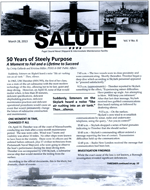 |
942k | Two page PDF on events leading to Thresher's (SSN-593) sinking and the creation of SUBSAFE. | Photograph courtesy of Ron Reeves (of blessed memory). | |
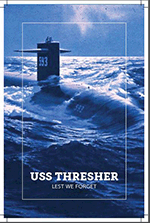 | 457k | 32 page PDF on Thresher's (SSN-593) memorial flagpole. Also a PDF on Information and Security Issues Associated with the Loss of the Thresher and Information on the Loss of the Scorpion (SSN-589) as it Relates to the Loss of Thresher. | PDF courtesy of Bob Hurley, Charles Tompkins & Ron Reeves (of blessed memory). | |
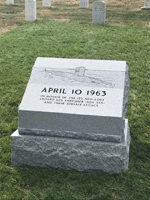 |
404k | 2 photo PDF of the new Thresher (SSN-593) Memorial at Arlington National Cemetery on the day of its dedication, 26 September 2019. | Photographs courtesy of Steve Walsh. | |
| Commanding Officers | |||
| 01 | CDR. Axene, Dean Lane, USN (USNA 1945) | 03.08.1961 - 18.01.1963 First Date in Commission | |
| 02 | CDR. Harvey, John Wesley, USN (USNA 1950) | 18.01.1963 - 10.04.1963 | |
View the Thresher (SSN-593)
DANFS history entry located on the Haze Gray & Underway Web Site.
Crew Contact And Reunion Information
U.S. Navy Memorial Foundation
Fleet Reserve Association
Additional Resources and Web Sites of Interest
ussthresher.com
On Eternal Patrol
Talk:USS Thresher (SSN-593) by Al Bonnyman
SSN-594 Permit Class - FAS web site
USS Thresher Memorial Ceremony
50th Annual USS Thresher Memorial Service
USS Thresher, Going Quietly
Scorpion and Thresher Wreckage Video
HISTORIC SUBMARINE DOCUMENTARY AND TRAINING FILMS
ussalbacore.org/memorial-garden
As you may know, Jim Bryant (CAPT. USN, Ret.), for former CO of THRESHER sister ship USS GUARDFISH (SSN 612), is getting the USN to redact and release the Testimonies and Exhibits of Court of Inquiry on the Loss of the THRESHER.The USN is releasing them at the rate of 300 pages per month and this is the link they get posted to on/about the 26th of every month (the first two months release is in there with this months’ set of 300 pages coming this week). secnav.navy.mil , Courtesy of Steve Walsh
| Back To The Main Photo Index | Back To the Submarine Index |
| Problems and site related matters, E-mail Webmaster |
| This page is created by Gary Priolo and maintained by Michael Mohl All Pages © 1996 - 2023, NavSource History All rights reserved. |